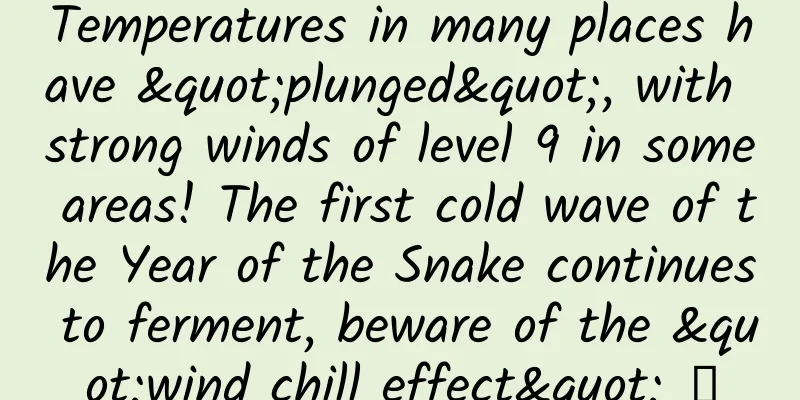Temperatures in many places have "plunged", with strong winds of level 9 in some areas! The first cold wave of the Year of the Snake continues to ferment, beware of the "wind chill effect" →

|
The Central Meteorological Observatory continued to issue a blue warning for cold waves at 06:00 on February 7: Affected by the cold wave, it is expected that from 08:00 on February 7 to 20:00 on February 8, the temperature in the southeastern part of the Northwest, southern North China, Huanghuai and other places will drop by 6-8℃, among which some areas in southern Huanghuai will drop by more than 10℃; most areas in the south will drop by 4-6℃, among which some areas in Jianghuai, Jiangnan, and South China will drop by 8-10℃, and the local temperature drop in the central and eastern parts of Jiangnan may reach more than 10℃. On the morning of the 8th, the minimum temperature of 0℃ will be pushed south to the area from southern Guizhou to southern Jiangnan. In addition, the temperature in the northern Qinghai-Tibet Plateau and the western part of the western Sichuan Plateau will also drop by 6-8℃. Image source: China National Meteorological Administration The Central Meteorological Observatory continued to issue a yellow gale warning at 06:00 on February 7: It is predicted that from 08:00 on February 7 to 08:00 on February 8, there will be northerly gale of 5~6 and gusts of 7~8 in parts of western Heilongjiang, western Jilin, western Liaoning and Liaodong Peninsula, central and eastern Inner Mongolia, North China, Huanghuai, eastern Jianghuai and other places. Among them, the maximum gusts may reach 9~10 in parts of eastern Inner Mongolia, northern North China, Shandong and other places; there will be gale of 7~8 and gusts of 9 in Bohai Sea, Bohai Strait, most waters of the Yellow Sea, northern waters of the East China Sea, Taiwan Strait, sea east of Taiwan, Bashi Strait, northern and central waters of the South China Sea. Among them, the wind force in parts of Bohai Strait, central Yellow Sea, Taiwan Strait, Bashi Strait, northeastern and central-eastern South China Sea may reach 9 and gusts of 10~11. In addition, some areas of central and northern Tibet, southern Qinghai, and the southern Xinjiang Basin will have strong westerly winds of 6 to 8 levels and gusts of 9 to 11 levels. From 08:00 on February 8 to 08:00 on February 9, parts of eastern Inner Mongolia and western Heilongjiang will have northerly strong winds of 5-6 and gusts of 7-8; the southern waters of the East China Sea, the Taiwan Strait, the sea east of Taiwan, the Bashi Strait, and most areas of the South China Sea will have strong winds of 7-8 and gusts of 9-10, among which the wind force in the Taiwan Strait, the Bashi Strait and parts of the northeastern and central-eastern South China Sea may reach 9 and gusts of 10-11. In addition, some areas of central and northern Tibet, central and southern Qinghai, and northern Sichuan Plateau will have strong westerly winds of 6 to 7 and gusts of 8 to 10. Image source: China National Meteorological Administration 01 Cold Wave Weather Warning Information According to the "Cold Wave Warning Signal and Defense Guidelines", cold wave warning signals are divided into four levels. 02 Cold Wave Blue Warning Protection Measures Guide In response to the blue warning for cold waves issued this time, we have put forward corresponding recommendations on protective measures for the population. 03 The first cold wave in the Year of the Snake, strong winds are more eye-catching than rain and snow Image source: China Weather Network Compared with the previous round of cold waves, the first cold wave in the Year of the Snake has a more significant impact of strong winds. Due to the large pressure gradient in front of the cold high pressure and the significant gradient wind effect, the impact of strong winds is more obvious than that of rain and snow. What is the concept of " extreme " gale ? What should we pay attention to ? The Beijing Meteorological Observatory reported on the afternoon of the 6th that due to the influence of strong cold air, the wind in Beijing increased in the afternoon. As of 16:30, the average wind speed in most parts of the city was 5 to 6, with gusts of about 7, and local gusts of 8 to 10. It is expected that strong winds will continue during the day on the 7th, and the temperature will remain low from the 7th to the 8th. Currently, the yellow warning signal for strong winds and the blue warning signal for continued low temperatures are in effect. Zhang Linna, chief forecaster of the Beijing Meteorological Observatory, said that the strong winds in Beijing this time were somewhat extreme, mainly because the wind speeds far exceeded those in the same period in history. The strongest gust in the observatory's history occurred on February 8, 1994, with a force 9 wind speed of 21.9 meters per second. The wind speed at the observatory is expected to be 8 to 9, between 19 meters per second and 21 meters per second. The gusts were particularly strong on the 6th and 7th. Experts suggested strengthening the inspection and reinforcement of lanterns, colored lights, outdoor structures, billboards and other facilities, ensuring safety protection for high-altitude operations, and relevant departments should do a good job in urban and forest fire prevention. 04 What is the wind chill effect? Why does it get colder when the wind blows? This cold air is also accompanied by a significant drop in temperature, low temperature and strong wind, and a significant wind chill effect. Under the effect of wind chill, the perceived temperature in the north from the evening of the 6th to the 7th will be 5~15℃ lower than the actual temperature. For example, in Beijing, the lowest temperature for three days from the 6th is predicted to be -11℃. With a wind force of about level 4, the perceived temperature will even be close to -20℃. The wind chill effect refers to the situation where, at a certain temperature, the body temperature is significantly lower than the air temperature due to the increase in wind force. This is because wind accelerates the loss of heat from the human body, making the body feel colder. Specifically: When the temperature is above 0℃, the perceived temperature will drop by 3℃ to 5℃ for every 2-level increase in wind speed; When the temperature is below 0℃, the perceived temperature will drop by 6℃ to 8℃ for every 2 levels increase in wind speed. Comprehensive sources: CCTV.com, China Meteorological Administration, CCTV News, etc. Note: The cover image is a copyrighted image. Reprinting it may cause copyright disputes. |
<<: You are afraid of snakes, so what are snakes afraid of?
>>: Should I take medicine three times a day with my meals? Many people take it wrong...
Recommend
Jet black AirPods hands-on experience: perfect match with iPhone 7
Although AirPods were badly criticized when they w...
"Singer" joins hands with Yingke Live. What else has Yingke Live done in operation and promotion?
As a fashionable live streaming product focusing ...
Case analysis: How to build a user incentive system?
The construction of a user incentive system is ge...
In the new semester, Beijing issued "new rules for physical education classes". How should upper limb training be performed?
Recently, the “Eight Rules for Physical Education...
Zhihu Q&A traffic promotion method!
Before talking about Zhihu , let me first tell yo...
New energy vehicle route: waver or stick to it?
my country's pure electric vehicles are in a ...
This is the entire process of a product from establishment to acquiring users!
In the early stages of entrepreneurship , from bu...
Nongfu Spring Advertising and Marketing Guide!
How important is the slogan? This article explain...
Stop it! If you love picking your nose, be careful not to damage your brain!
Source: Dr. Curious The cover image of this artic...
How to distinguish true and false users through data indicators
What operators may encounter: When doing channel ...
Why does the effect of the same copy differ so much when it is delivered in different cities?
Marketing is a war of perception . When we want t...
The most comprehensive guide to campus promotion activities!
Today I will share with you the most comprehensiv...
World Maritime Day丨The navigational artifact "compass" actually originated from divination?
Sailing is a journey for people to explore the wo...
Tips for creating popular articles on Baijiahao, teaching you how to create popular articles on Baijiahao?
Today I will give you some of my humble opinions ...
Please check out the 618 marketing strategy for the wedding photography industry!
This article shares with you Tencent Advertising’...









